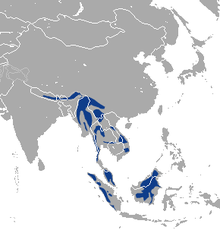Marbled cat
| Marbled cat | |
|---|---|
 |
|
| Scientific classification | |
| Kingdom: | Animalia |
| Phylum: | Chordata |
| Class: | Mammalia |
| Order: | Carnivora |
| Family: | Felidae |
| Subfamily: | Felinae |
| Genus: | Pardofelis |
| Species: | P. marmorata |
| Binomial name | |
|
Pardofelis marmorata (Martin, 1836) |
|
| Subspecies | |
|
|
 |
|
| Marbled cat range | |
The marbled cat (Pardofelis marmorata) is a small wild cat of South and Southeast Asia, where it is suspected to occur over a large range. It is listed as Near Threatened on the IUCN Red List.
The marbled cat was once considered to belong to the pantherine lineage of cats.Genetic analysis has shown it to be closely related to the Asian golden cat and the bay cat, all of which diverged from other felids about 9.4 million years ago.
The marbled cat is similar in size to a domestic cat, with a more thickly furred tail (which may be longer than the body), showing adaptation to its arboreal lifestyle, where the tail is used as a counterbalance. Marbled cats range from 45 to 62 cm (18 to 24 in) in head-body length, with a 35- to 55-cm tail. Recorded weights vary between 2 and 5 kg (4.4 and 11.0 lb). The coat is thick and soft, and varies in background color from dark grey-brown through yellowish grey to red-brown. Spots on the forehead and crown merge into narrow longitudinal stripes on the neck, and irregular stripes on the back. The back and flanks are marked with dark, irregular dark-edged blotches. The legs and underparts are patterned with black dots, and the tail is marked with black spots proximally and rings distally. In addition to its long tail, the marbled cat can also be distinguished by its large feet. It also possesses unusually large canine teeth, resembling those of the big cats, although these appear to be the result of parallel evolution.
When standing or resting, marbled cats assume a characteristic position with their backs arched.
The marbled cat occurs along the Himalayan foothills and in tropical Indomalaya eastward into southwest China, and on the islands of Sumatra and Borneo. It is primarily associated with moist and mixed deciduous-evergreen tropical forests. In Borneo, it has also been recorded in peat swamp forest.
...
Wikipedia

